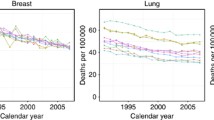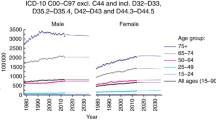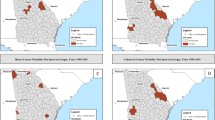Abstract
Purpose
In recent years, cancer case counts in the U.S. underwent a large, rapid decline—an unexpected change given population growth for older persons at highest cancer risk. As these declines coincided with the Great Recession, we examined whether they were related to economic conditions.
Methods
Using California Cancer Registry data from California’s 30 most populous counties, we analyzed trends in cancer incidence during pre-recession (1996–2007) and recession/recovery (2008–2012) periods for all cancers combined and the ten most common sites. We evaluated the recession’s association with rates using a multifactorial index that measured recession impact, and modeled associations between case counts and county-level unemployment rates using Poisson regression.
Results
Yearly cancer incidence rate declines were greater during the recession/recovery (3.3% among males, 1.4% among females) than before (0.7 and 0.5%, respectively), particularly for prostate, lung, and colorectal cancers. Lower case counts, especially for prostate and liver cancer among males and breast cancer, melanoma, and ovarian cancer among females, were associated with higher unemployment rates, irrespective of time period, but independent of secular effects. The associations for melanoma translated up to a 3.6% decrease in cases with each 1% increase in unemployment. Incidence declines were not greater in counties with higher recession impact index.
Conclusions
Although recent declines in incidence of certain cancers are not differentially impacted by economic conditions related to the Great Recession relative to pre-recession conditions, the large recent absolute declines in the case counts of some cancer may be attributable to the large declines in unemployment in the recessionary period. This may occur through decreased engagement in preventive health behaviors, particularly for clinically less urgent cancers. Continued monitoring of trends is important to detect any rises in incidence rates as deferred diagnoses come to clinical attention.


Similar content being viewed by others
References
Krieger N (2001) Theories for social epidemiology in the 21st century: an ecosocial perspective. Int J Epidemiol 30(4):668–677
Maruthappu M, Watson R, Watkins J et al (2015) Unemployment, public-sector healthcare expenditure and colorectal cancer mortality in the European Union: 1990–2009. Int J Public Health 1–12
Mustard CA, Bielecky A, Etches J et al (2013) Mortality following unemployment in Canada, 1991–2001. BMC Public Health 13:441
Singh G, Siahpush M, Altekruse S (2013) Time Trends in Liver Cancer Mortality, Incidence, and Risk Factors by Unemployment Level and Race/Ethnicity, United States, 1969–2011. J Community Health 38(5):926–940
Smith ND, Prasad SM, Patel AR, et al (2015) Bladder Cancer Mortality in the United States: a geographic and temporal analysis of socioeconomic and environmental factors. J Urol;epub July 30.
Vrachnis N, Vlachadis N, Salakos N, Vlachadi M, Iliodromiti Z (2015) Cancer mortality in Greece during the financial crisis. Acta Oncol 54:287–288
Lewis DR, Chen H-S, Midthune DN, Cronin KA, Krapcho MF, Feuer EJ (2015) Early estimates of SEER cancer incidence for 2012: approaches, opportunities, and cautions for obtaining preliminary estimates of cancer incidence. Cancer 121(12):2053–2062
Regidor E, Barrio G, Bravo MJ, de la Fuente L (2014) Has health in Spain been declining since the economic crisis? J Epidemiol Community Health 68(3):280–282
Neumayer E (2004) Recessions lower (some) mortality rates: evidence from Germany. Soc Sci Med 58(6):1037–1047
Ruhm CJ (2005) Commentary: mortality increases during economic upturns. Int J Epidemiol 34(6):1206–1211
Ennis KY, Chen M-H, Smith GC et al (2015) The impact of economic recession on the incidence and treatment of cancer. J Cancer 6(8):727–733
Yost K, Perkins C, Cohen R, Morris C, Wright W (2001) Socioeconomic status and breast cancer incidence in California for different race/ethnic groups. Cancer Causes Control 12(8):703–711
Yang J, Schupp CW, Harrati A, Clarke C, Keegan TH, Gomez SL (2014) Developing an area-based socioeconomic measure from American Community Survey data. http://www.cpic.org/files/PDF/Research_Files/Reports/CPIC_ACS_SES_Index_Documentation_3-10-2014.pdf, Accessed August 24, 2016
Lavarreda SA, Snyder S, Brown ER (2013) The effects of the Great Recession on health insurance: changes in the uninsured population from 2007 to 2009. Policy Brief UCLA Cent Health Policy Res. (PB2013-5):1–8.
Kim HJ, Fay MP, Feuer EJ, Midthune DN (2000) Permutation tests for joinpoint regression with applications to cancer rates. Stat Med 19:335–351 (correction: 2001;2020:2655).
Kohler BA, Sherman RL, Howlader N, et al (2015) Annual Report to the Nation on the Status of Cancer, 1975–2011, Featuring Incidence of Breast Cancer Subtypes by Race/Ethnicity, Poverty, and State. J Natl Cancer Inst 107(6):djv048
Toffolutti V, Suhrcke M (2014) Assessing the short term health impact of the Great Recession in the European Union: a cross-country panel analysis. Prev Med 64:54–62
Catalano R (2009) Health, medical care, and economic crisis. N Engl J Med 360(8):749–751
Weiner AB, Conti RM, Eggener SE (2015) National economic conditions and patient insurance status predict prostate cancer diagnosis rates and management decisions. J Urol
Dorn SD, Wei D, Farley JF et al (2012) Impact of the 2008–2009 economic recession on screening colonoscopy utilization among the insured. Clin Gastroenterol Hepatol 10(3):278–284
Myong JP, Kim HR (2012) Impacts of household income and economic recession on participation in colorectal cancer screening in Korea. Asian Pac J Cancer Prev 13(5):1857–1862
King CJ, Chen J, Garza MA, Thomas SB (2014) Breast and cervical screening by race/ethnicity: comparative analyses before and during the Great Recession. Am J Prev Med 46(4):359–367
Catalano RA, Satariano WA (1998) Unemployment and the likelihood of detecting early-stage breast cancer. Am J Public Health 88(4):586–589
Catalano RA, Satariano WA, Ciemins EL (2003) Unemployment and the detection of early stage breast tumors among African Americans and non-Hispanic whites. Ann Epidemiol 13(1):8–15
Bruckner T, Catalano RA (2006) Economic antecedents of sudden infant death syndrome. Ann Epidemiol 16(6):415–422
Burgard SA, Hawkins JM (2014) Race/ethnicity, educational attainment, and foregone health care in the United States in the 2007–2009 recession. Am J Public Health 104(2):e134–e140
Martin-Moreno JM, Alfonso-Sanchez JL, Harris M, Lopez-Valcarcel BG (2010) The effects of the financial crisis on primary prevention of cancer. Eur J Cancer 46(14):2525–2533
Kalousova L, Burgard SA (2014) Unemployment, measured and perceived decline of economic resources: contrasting three measures of recessionary hardships and their implications for adopting negative health behaviors. Soc Sci Med 106:28–34
Catalano R, Goldman-Mellor S, Saxton K et al (2011) The health effects of economic decline. Annu Rev Public Health 32:431–450
Green CA, Pope CR (1999) Gender, psychosocial factors and the use of medical services: a longitudinal analysis. Soc Sci Med 48(10):1363–1372
Koopmans GT, Lamers LM (2007) Gender and health care utilization: the role of mental distress and help-seeking propensity. Soc Sci Med 64(6):1216–1230
Gender differences in health care, status, and use: spotlight on men’s health (2016) http://kff.org/womens-health-policy/fact-sheet/gender-differences-in-health-care-status-and-use-spotlight-on-mens-health/. Accessed August 31, 2016
Jacob JA (2016) Greater Health Care Spending May Moderate Recession’s Negative Health Effects. Jama 315(3):237–239
Acknowledgments
The collection of cancer incidence data used in this study was supported by the California Department of Public Health as part of the statewide cancer reporting program mandated by California Health and Safety Code Sect. 103885; the National Cancer Institute’s Surveillance, Epidemiology and End Results Program under contract HHSN261201000140C awarded to the Cancer Prevention Institute of California, contract HHSN261201000035C awarded to the University of Southern California, and contract HHSN261201000034C awarded to the Public Health Institute; and the Centers for Disease Control and Prevention’s National Program of Cancer Registries, under agreement U58DP003862-01 awarded to the California Department of Public Health. The ideas and opinions expressed herein are those of the author(s) and endorsement by the State of California, Department of Public Health the National Cancer Institute, and the Centers for Disease Control and Prevention or their Contractors and Subcontractors is not intended nor should be inferred.
Author information
Authors and Affiliations
Corresponding author
Ethics declarations
Conflict of interest
None.
Funding
This work was funded in part by the Stanford Cancer Institute (Drs. Gomez, Glaser, Nelson and DeRouen), and the National Cancer Institute’s Surveillance, Epidemiology and End Results Program under contract HHSN261201000140C awarded to the Cancer Prevention Institute of California (Drs. Clarke, Keegan, Cheng, and Shariff-Marco; Ms. Canchola; and Ms. Davidson-Allen).
Rights and permissions
About this article
Cite this article
Gomez, S.L., Canchola, A.J., Nelson, D.O. et al. Recent declines in cancer incidence: related to the Great Recession?. Cancer Causes Control 28, 145–154 (2017). https://doi.org/10.1007/s10552-016-0846-y
Received:
Accepted:
Published:
Issue Date:
DOI: https://doi.org/10.1007/s10552-016-0846-y




